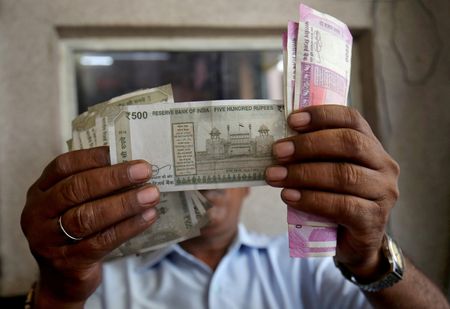By Dharamraj Dhutia
MUMBAI (Reuters) -The rupee struggled for direction on Thursday, stuck in a narrow range before ending marginally higher, as inflows into local shares and dollar-selling by state-run banks offset importer demand for the U.S. currency for hedging.
The rupee had opened higher at 87.8325 per U.S. dollar, buoyed by a media report that Washington may cut tariffs on Indian imports to 15%–16% from 50%.
However, the advance was soon reversed, with the currency dropping to 87.96 intraday, before recovering again to end at higher at 87.84. It had settled at 87.9275 on Monday.
Indian foreign-exchange and money markets were shut Tuesday and Wednesday for Diwali holidays.
“Now we all know, 88 is the key level that needs to be protected, and whenever the central bank feels the level is close to be breached, they will make their presence felt,” trader with a state-run bank said.
The Reserve Bank of India has been seen selling dollars through state-run banks whenever the rupee has weakened toward 88, a move traders say is likely aimed at extending the impact of its heavy intervention last Wednesday.
“We do not rule out further dollar-selling intervention in the days ahead, but unless the currency undergoes a renewed sharp move back towards 89-90 to the USD, we would expect such intervention to be more limited, going forward,” Mitul Kotecha, head of FX & EM macro strategy Asia at Barclays Bank, said in a note.
Meanwhile, Reuters reported that U.S. President Donald Trump is considering curbs on software-enabled exports to China — ranging from laptops to jet engines — in response to Beijing’s restrictions on rare earth shipments, which undermining demand for Asian currencies.
(Reporting by Dharamraj Dhutia; Editing by Harikrishnan Nair, Ronojoy Mazumdar and Janane Venkatraman)











